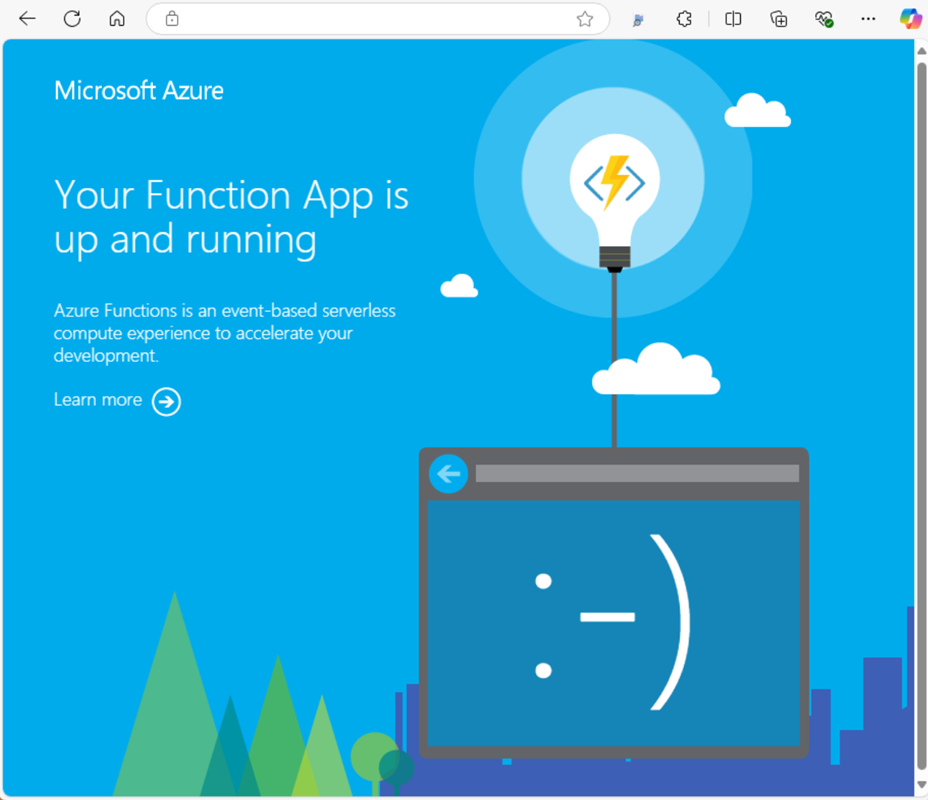在本快速入门中,你将使用 Terraform 在 Azure Functions 中的 Flex Consumption 计划中创建函数应用,以及其他所需的 Azure 资源。 Flex Consumption 计划提供无服务器托管,使你可以按需运行代码,而无需显式预配或管理基础结构。 函数应用在 Linux 上运行,并配置为使用 Azure Blob 存储进行代码部署。
使用 Terraform 可以定义、预览和部署云基础结构。 使用 Terraform 时,请使用 HCL 语法来创建配置文件。 利用 HCL 语法,可指定 Azure 这样的云提供程序和构成云基础结构的元素。 创建配置文件后,请创建一个执行计划,利用该计划,可在部署基础结构更改之前先预览这些更改。 验证了更改后,请应用该执行计划以部署基础结构。
- 创建具有唯一名称的 Azure 资源组。
- 生成一个 13 个小写字母的随机字符串来命名资源。
- 在 Azure 中创建存储帐户。
- 在存储帐户中创建 Blob 存储容器。
- 在 Azure Functions 中创建 Flex 消耗计划。
- 在 Azure 中使用 Flex Consumption 计划创建函数应用。
- 输出资源组、存储帐户、服务计划、函数应用和 Azure Functions 弹性消耗计划的名称。
先决条件
- 创建具有活动订阅的 Azure 帐户。 可以创建帐户。
- 安装和配置Terraform。
实现 Terraform 代码
本文中的示例代码位于 Azure Terraform GitHub 存储库中。 你可以查看包含当前和以前 Terraform 版本的测试结果的日志文件。
创建用于测试和运行示例 Terraform 代码的目录,并将其设为当前目录。
创建名为
main.tf的文件并插入以下代码:
# This Terraform configuration creates a Flex Consumption plan app in Azure Functions
# with the required Storage account and Blob Storage deployment container.
# Create a random pet to generate a unique resource group name
resource "random_pet" "rg_name" {
prefix = var.resource_group_name_prefix
}
# Create a resource group
resource "azurerm_resource_group" "example" {
location = var.resource_group_location
name = random_pet.rg_name.id
}
# Random String for unique naming of resources
resource "random_string" "name" {
length = 8
special = false
upper = false
lower = true
numeric = false
}
# Create a storage account
resource "azurerm_storage_account" "example" {
name = coalesce(var.sa_name, random_string.name.result)
resource_group_name = azurerm_resource_group.example.name
location = azurerm_resource_group.example.location
account_tier = var.sa_account_tier
account_replication_type = var.sa_account_replication_type
}
# Create a storage container
resource "azurerm_storage_container" "example" {
name = "example-flexcontainer"
storage_account_id = azurerm_storage_account.example.id
container_access_type = "private"
}
# Create a Log Analytics workspace for Application Insights
resource "azurerm_log_analytics_workspace" "example" {
name = coalesce(var.ws_name, random_string.name.result)
location = azurerm_resource_group.example.location
resource_group_name = azurerm_resource_group.example.name
sku = "PerGB2018"
retention_in_days = 30
}
# Create an Application Insights instance for monitoring
resource "azurerm_application_insights" "example" {
name = coalesce(var.ai_name, random_string.name.result)
location = azurerm_resource_group.example.location
resource_group_name = azurerm_resource_group.example.name
application_type = "web"
workspace_id = azurerm_log_analytics_workspace.example.id
}
# Create a service plan
resource "azurerm_service_plan" "example" {
name = coalesce(var.asp_name, random_string.name.result)
resource_group_name = azurerm_resource_group.example.name
location = azurerm_resource_group.example.location
sku_name = "FC1"
os_type = "Linux"
}
# Create a function app
resource "azurerm_function_app_flex_consumption" "example" {
name = coalesce(var.fa_name, random_string.name.result)
resource_group_name = azurerm_resource_group.example.name
location = azurerm_resource_group.example.location
service_plan_id = azurerm_service_plan.example.id
storage_container_type = "blobContainer"
storage_container_endpoint = "${azurerm_storage_account.example.primary_blob_endpoint}${azurerm_storage_container.example.name}"
storage_authentication_type = "StorageAccountConnectionString"
storage_access_key = azurerm_storage_account.example.primary_access_key
runtime_name = var.runtime_name
runtime_version = var.runtime_version
maximum_instance_count = 50
instance_memory_in_mb = 2048
site_config {
}
}
- 创建名为
outputs.tf的文件并插入以下代码:
output "resource_group_name" {
value = azurerm_resource_group.example.name
}
output "sa_name" {
value = azurerm_storage_account.example.name
}
output "asp_name" {
value = azurerm_service_plan.example.name
}
output "fa_name" {
value = azurerm_function_app_flex_consumption.example.name
}
output "fa_url" {
value = "https://${azurerm_function_app_flex_consumption.example.name}.chinacloudsites.cn"
}
- 创建名为
providers.tf的文件并插入以下代码:
terraform {
required_version = ">=1.0"
required_providers {
azurerm = {
source = "hashicorp/azurerm"
version = "~>4.0"
}
random = {
source = "hashicorp/random"
version = "~>3.0"
}
}
}
provider "azurerm" {
features {}
}
- 创建名为
variables.tf的文件并插入以下代码:
variable "resource_group_name" {
type = string
default = ""
description = "The name of the Azure resource group. If blank, a random name will be generated."
}
variable "resource_group_name_prefix" {
type = string
default = "rg"
description = "Prefix of the resource group name that's combined with a random ID so name is unique in your Azure subscription."
}
variable "resource_group_location" {
type = string
default = "chinanorth2"
description = "Location of the resource group."
}
variable "sa_account_tier" {
description = "The tier of the storage account. Possible values are Standard and Premium."
type = string
default = "Standard"
}
variable "sa_account_replication_type" {
description = "The replication type of the storage account. Possible values are LRS, GRS, RAGRS, and ZRS."
type = string
default = "LRS"
}
variable "sa_name" {
description = "The name of the storage account. If blank, a random name will be generated."
type = string
default = ""
}
variable "ws_name" {
description = "The name of the Log Analytics workspace. If blank, a random name will be generated."
type = string
default = ""
}
variable "ai_name" {
description = "The name of the Application Insights instance. If blank, a random name will be generated."
type = string
default = ""
}
variable "asp_name" {
description = "The name of the App Service Plan. If blank, a random name will be generated."
type = string
default = ""
}
variable "fa_name" {
description = "The name of the Function App. If blank, a random name will be generated."
type = string
default = ""
}
variable "runtime_name" {
description = "The name of the language worker runtime."
type = string
default = "node" # Allowed: dotnet-isolated, java, node, powershell, python
}
variable "runtime_version" {
description = "The version of the language worker runtime."
type = string
default = "20" # Supported versions: see https://aka.ms/flexfxversions
}
使用此 Azure CLI 命令将
ARM_SUBSCRIPTION_ID环境变量设置为当前订阅的 ID:export ARM_SUBSCRIPTION_ID=$(az account show --query "id" --output tsv)必须为 Terraform 设置此变量才能向 Azure 订阅进行身份验证。
初始化 Terraform
运行 terraform init,将 Terraform 部署进行初始化。 此命令将下载管理 Azure 资源所需的 Azure 提供程序。
terraform init -upgrade
要点:
- 参数
-upgrade可将必要的提供程序插件升级到符合配置版本约束的最新版本。
创建 Terraform 执行计划
运行 terraform plan 以创建执行计划。
terraform plan -out main.tfplan -var="runtime_name=dotnet-isolated" -var="runtime_version=8"
terraform plan -out main.tfplan -var="runtime_name=powershell" -var="runtime_version=7.4"
terraform plan -out main.tfplan -var="runtime_name=python" -var="runtime_version=3.12"
terraform plan -out main.tfplan -var="runtime_name=java" -var="runtime_version=21"
terraform plan -out main.tfplan -var="runtime_name=node" -var="runtime_version=20"
请确保 runtime_version 与本地验证的语言堆栈版本匹配。 选择文章 顶部 的首选语言堆栈。
要点:
-
terraform plan命令将创建一个执行计划,但不会执行它。 相反,它会确定需要执行哪些操作,以创建配置文件中指定的配置。 此模式允许你在对实际资源进行任何更改之前验证执行计划是否符合预期。 - 使用可选
-out参数可以为计划指定输出文件。 使用-out参数可以确保所查看的计划与所应用的计划完全一致。 - 若要详细了解如何保留执行计划和安全性,请参阅 安全警告部分。
应用 Terraform 执行计划
运行 terraform apply 以将执行计划应用到您的云基础架构。
terraform apply main.tfplan
要点:
- 示例
terraform apply命令假设你先前运行了terraform plan -out main.tfplan。 - 如果为
-out参数指定了不同的文件名,请在对terraform apply的调用中使用该相同文件名。 - 如果未使用
-out参数,请调用不带任何参数的terraform apply。
验证结果
该文件 outputs.tf 为新的函数应用返回以下值:
| 价值 | Description |
|---|---|
resource_group_name |
创建的资源组的名称。 |
sa_name |
Functions 主机所需的 Azure 存储帐户的名称。 |
asp_name |
托管新应用的弹性消耗计划的名称。 |
fa_name |
新函数应用的名称。 |
fa_url |
新函数应用终结点的 URL。 |
打开浏览器并浏览到 URL 位置。fa_url 还可以使用 terraform 输出 命令在以后查看这些值。

清理资源
不再需要通过 Terraform 创建的资源时,请执行以下步骤:
运行 terraform plan 并指定
destroy标志。terraform plan -destroy -out main.destroy.tfplan要点:
-
terraform plan命令将创建一个执行计划,但不会执行它。 相反,它会确定需要执行哪些操作,以创建配置文件中指定的配置。 此模式允许你在对实际资源进行任何更改之前验证执行计划是否符合预期。 - 使用可选
-out参数可以为计划指定输出文件。 使用-out参数可以确保所查看的计划与所应用的计划完全一致。 - 若要详细了解如何保留执行计划和安全性,请参阅 安全警告部分。
-
运行 terraform apply 来应用执行计划。
terraform apply main.destroy.tfplan
Azure 上的 Terraform 故障排除
排查在 Azure 上使用 Terraform 时遇到的常见问题。
后续步骤
现在可以将代码项目部署到在 Azure 中创建的函数应用资源。
可以从这些本地环境创建、验证代码项目并将其部署到新的函数应用: